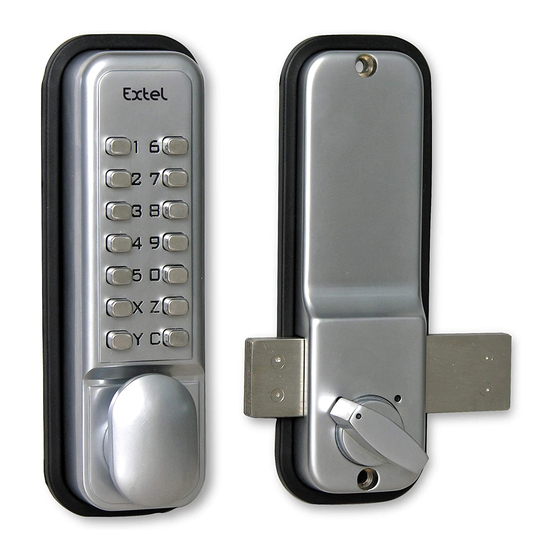Table des Matières
Publicité
Les langues disponibles
Les langues disponibles
Liens rapides
WECA 109057
08-08 V1
VERROU AUTONOME AVEC PENE EN APPLIQUE
Pour porte de 35 mm à 60 mm
Pour une ouverture à gauche ou à droite - Gabarit de pose
ZELFSTANDIG SLOT MET SCHOOT ALS OPLEGPLAAT
Voor deur van 35 tot 60 mm
Links openend of rechts openend - Installatiemodel (mal)
AUTONOMES TÜRSCHLOSS MIT FALLE UND SCHLIESSBLECH
ZUM AUF- ODER EINSETZEN
Türstärken von 35 mm bis 60 mm
Links oder rechts öffnend - Montageschablone
SURFACE-MOUNTED AUTONOMOUS BOLT
For door from 35 mm to 60 mm
For left or right hand opening - Installation template
SERRATURA A CODICE CON SCROCCO DA APPLICARE
Per porta da 35 mm a 60 mm
Per apertura mano destra o sinistra - Sagoma di montaggio
SISTEMA DE BLOQUEO AUTÓNOMO CON PESTILLO DE SOBREPONER
Para puertas de 35-60 mm
Para una apertura hacia la izquierda o hacia la derecha - Plantilla de montaje
FECHADURA AUTÓNOMA COM LINGUETA EM APLIQUE
Para porta de 35 mm a 60 mm
Para uma abertura à esquerda ou à direita - Modelo de instalação
M
'
'
ODE D
EMPLOI ET D
INSTALLATION
H
ANDLEIDING VOOR INSTALLATIE EN GEBRUIK
I
-
B
NSTALLATIONS
UND
EDIENUNGSANLEITUNG
I
NSTALLATION AND OPERATION MANUAL
I
STRUZIONI DI UTILIZZO E INSTALLAZIONE
I
NSTRUCCIONES DE USO E INSTALACIÓN
MODO DE EMPREGO E DE INSTALAÇÃO
Publicité
Table des Matières

Sommaire des Matières pour Extel WECA 109057
- Page 1 WECA 109057 08-08 V1 VERROU AUTONOME AVEC PENE EN APPLIQUE Pour porte de 35 mm à 60 mm Pour une ouverture à gauche ou à droite - Gabarit de pose ZELFSTANDIG SLOT MET SCHOOT ALS OPLEGPLAAT Voor deur van 35 tot 60 mm Links openend of rechts openend - Installatiemodel (mal) AUTONOMES TÜRSCHLOSS MIT FALLE UND SCHLIESSBLECH...
- Page 2 60mm 60mm...
-
Page 3: Liste Des Pieces
1. LISTE DES PIECES a) Bloc clavier. b) Bloc intérieur. c) 2 flasques néoprènes. d) Carré. e) Gâche à encastrer. f) Gâche en applique. g) Vis de fixation. h) Vis d’assemblage. 2. AVANT DE COMMENCER LA POSE a - Vérifier que toutes les pièces fonctionnent correctement ensemble. b - Choisir un code en suivant les instructions «modifications du code d’entrée». -
Page 4: Modifications Du Code D'entrée
Modifications du code d’entrée : Vous avez la possibilité d’utiliser une partie ou tous les fig. M poussoirs pour coder l’ouverture par la poignée. Aucun ordre dans la numérotation n’est demandé. Sur le dos du clavier “fig. M” on peut apercevoir les éléments qui prolongent les poussoirs du clavier. -
Page 5: Configuration Du Verrou Pour Une Ouvertureà Gauche Ou À Droite
4. CONFIGURATION DU VERROU POUR UNE OUVERTURE À GAUCHE OU À DROITE Si besoin vous avez la possibilité d’inverser le sens du déverrouillage. a - Pressez le bouton « C » pour remettre à zéro le mécanisme. b - Enlevez la plaque centrale du boîtier en retirant préalablement les 2 vis (repère Z). c - A l’aide d’une petite pince, retirez la goupille et la repositionner à... -
Page 6: Positionnement Du Verrou
5. POSITIONNEMENT DU VERROU IMPORTANT : Déterminez la gâche qu’il convient d’utiliser (encastrée ou en applique) et tracez sa position sur le cadre avant de percer la porte. ATTENTION : Le pêne sort de 35 mm par rapport au côté du verrou. Présentez le bloc intérieur avec la poignée en position verticale et tenez-le sur la porte avec une extrémité... -
Page 7: Installation De La Gache
7. INSTALLATION DE LA GACHE 8. 1 Gâche encastrée Gâche en applique En premier, choisir le type de gâche qui convient pour votre porte puis positionnez la gâche sur le cadre de telle sorte qu’elle soit alignée avec le pêne et marquer les trous correspondants. Si vous utilisez la gâche en applique, vissez la simplement (figure 8.1).


